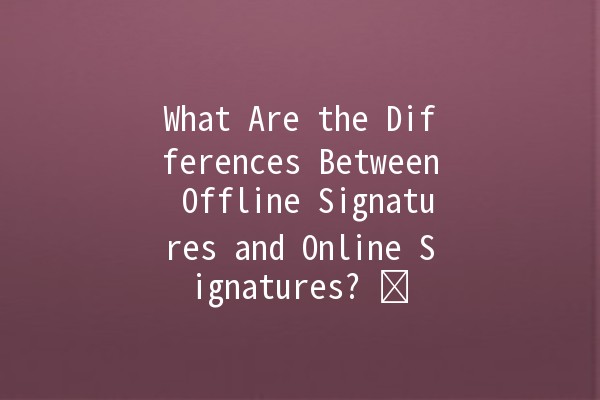




In the digital age, signatures have evolved beyond their traditional handwritten forms. They now exist in two primary formats: offline signatures, which are physical signatures made with a pen; and online signatures, which are digital representations executed on electronic platforms. Understanding the differences between these two types of signatures can guide individuals and organizations in selecting the most suitable option for their needs. This article explores the distinctions, benefits, and implications of both signature types.
Offline signatures refer to traditional handwritten signatures physically made on paper or other tangible materials. They often require the signer to be present in person, providing a level of authenticity and personal touch that some individuals and organizations still value.

Contracts and Legal Documents: Often required for agreements where parties want undeniable proof of consent.
Banking and ancial Transactions: Many banks still rely on offline signatures for account openings, loan applications, and legal declarations.
Official Government Forms: Many governmentrelated documents still necessitate offline signatures due to regulations and compliance.
Online signatures, also known as digital or electronic signatures, refer to signatures created and stored digitally. These signatures can be executed using various electronic tools, software, and apps, providing a modern alternative to traditional handwritten signatures.
Business Contracts: Many businesses use online signatures for agreements, streamlining processes and reducing turnaround time.
Ecommerce Transactions: Ecommerce platforms often employ online signatures for order confirmations and purchase agreements.
Remote Work Agreements: With the rise of remote work, online signatures are pivotal for efficiency in signing employment contracts or project agreements.
Offline: Verification relies on the physical presence of the signer and could include features like notary services for additional security.
Online: Digital signatures often use multifactor authentication, requiring users to verify their identity through various methods.
Offline: Wellestablished laws exist governing the use of offline signatures, although they can vary by jurisdiction.
Online: Despite recent advancements in digital signatures, they remain a legal gray area in some regions, although recognition is growing globally.
Offline: Requires an inperson meeting, making it less convenient, especially for remote transactions.
Online: Accessible from anywhere, making it convenient for parties in different locations to complete agreements rapidly.
Offline: Often incurs costs for printing, storing, and mailing documents.
Online: Generally encompasses a subscription fee for digital signature software but can save money through reduced paper and storage needs.
Offline: Contributes to deforestation and waste due to paper usage.
Online: Environmentally friendly as it reduces paper consumption.
Managing signatures efficiently can significantly enhance productivity within an organization. Here are five strategies to consider for improving signature workflow:
Using digital signature software can streamline the signing process. Platforms like DocuSign or Adobe Sign allow users to send documents for signature digitally, reducing processing time from days to mere minutes. Companies may track the document status in realtime, ensuring nothing is overlooked.
Example: A company can automate contract sending and tracking, allowing them to focus on more strategic tasks instead of chasing signatures.
Having a centralized location for all documents can enhance security and retrieve speed for both offline and online signatures. Digital documents can be stored and categorized effectively within cloudbased systems.
Example: A real estate firm can use a document management system to keep track of all signed sales contracts in one secure location, easily accessible for audits or future references.
Creating awareness around secure digital signature practices can prevent unauthorized access and maintain compliance with legal standards. Regular training can enhance employees' understanding of signature tools and their importance.
Example: A company implementing a new digital signature tool conducts workshops, ensuring all employees are confident in transitioning from offline to online signatures.
Implement automation for document reminders. Automation can notify signers when a document is ready for signature or highlight deadlines for signing critical documents.
Example: A law firm could automate reminders for contract renewals, prompting clients to sign updated agreements on time.
Integrating digital signature solutions with other software tools (like CRM or project management systems) can ensure a seamless flow of information. This can enhance workflow efficiency and save time spent transferring data between platforms.
Example: A marketing team can integrate their digital signature software with their project management tool to easily send contracts for approval without leaving the platform.
Yes, online signatures are legally binding in many jurisdictions, provided they meet specific criteria. Regulations like the U.S. ESIGN Act and the European eIDAS Regulation establish legal frameworks supporting digital signatures. However, it's essential to review the laws in your area to ensure compliance.
Online signatures offer superior security features, including encryption and authentication methods, making them less susceptible to forgery than traditional offline signatures. Many digital signature platforms use advanced security measures to protect user data, adding layers of safety that offline signatures typically lack.
Yes, many digital signature solutions allow users to upload a scanned image of their offline signatures. However, it's important to verify the legality of this approach in your jurisdiction, as some agreements may require an electronic signature.
The costs for online signatures can vary depending on the service provider. Pricing models typically include monthly subscriptions or payperuse fees. While there may be upfront costs for software, the savings on paper, printing, and time can be substantial in the long run.
Most documents that require signatures can be signed online, including contracts, agreements, forms, and real estate deeds. However, some legal documents may still require physical signatures depending on jurisdictional regulations.
To ensure the authenticity of an online signature, utilize platforms that employ verified digital signature technology, use multifactor authentication, and keep a record of signing events (e.g., timestamps, IP addresses). These measures greatly enhance the credibility of electronic documents.
By understanding the differences between offline and online signatures, individuals and organizations can make informed decisions regarding which method best suits their needs. Implementing effective signature management strategies can further improve productivity and ensure the legal integrity of documents.